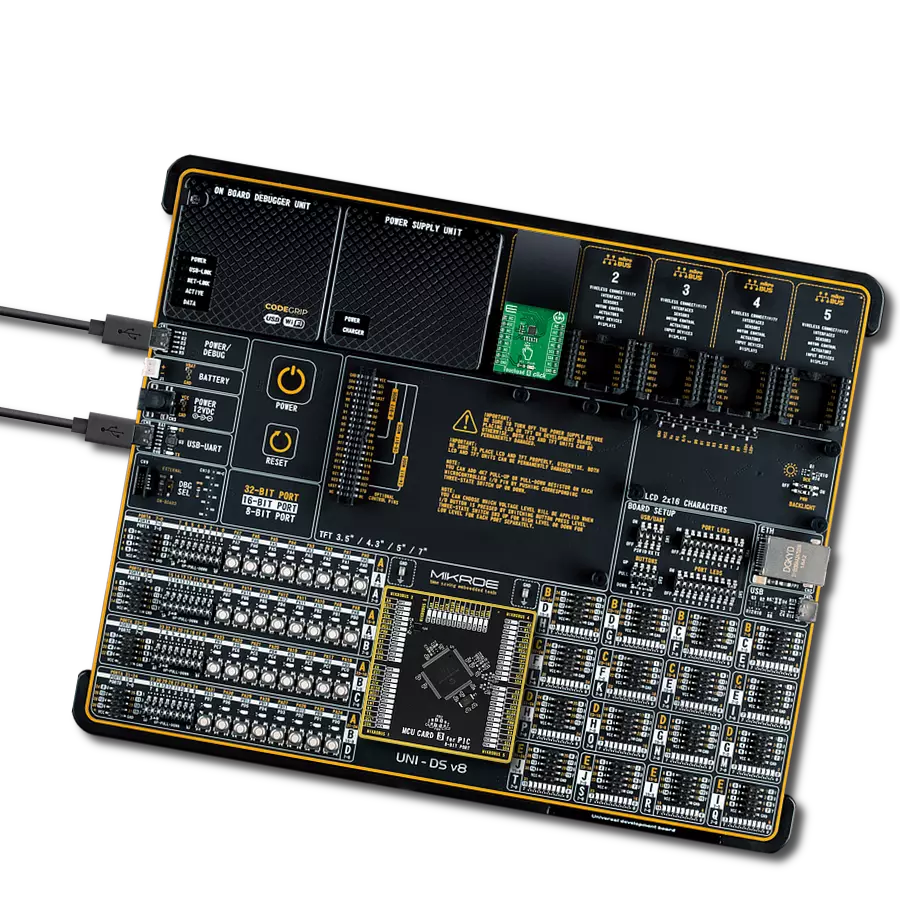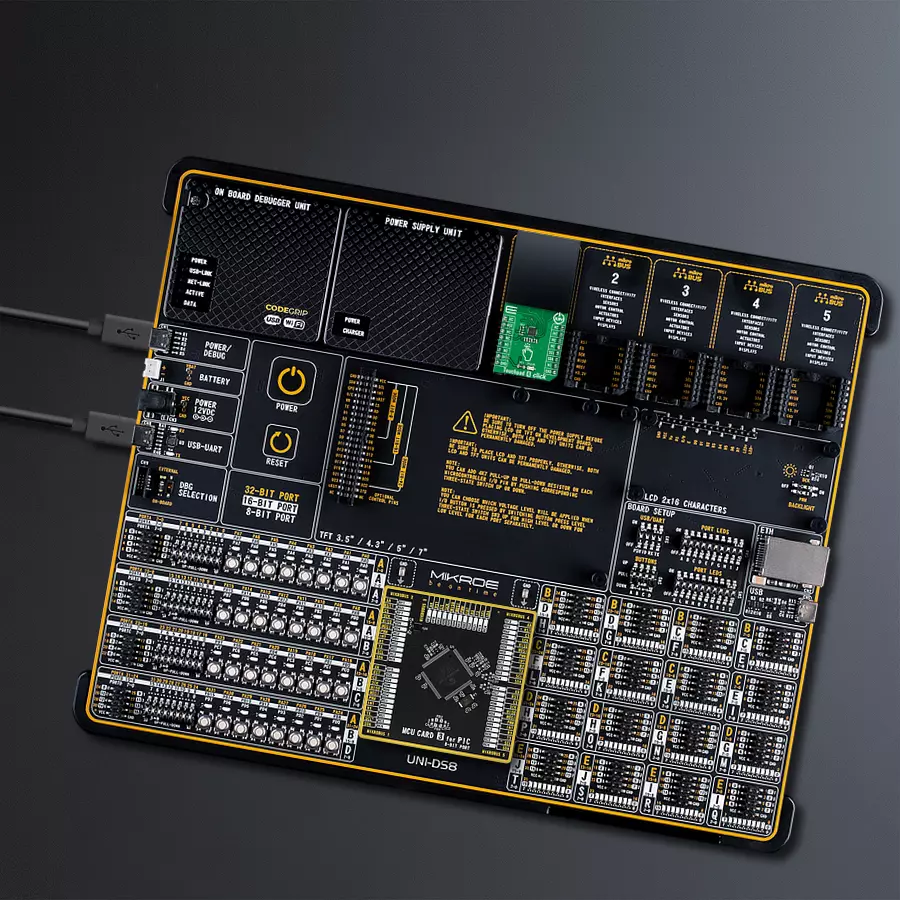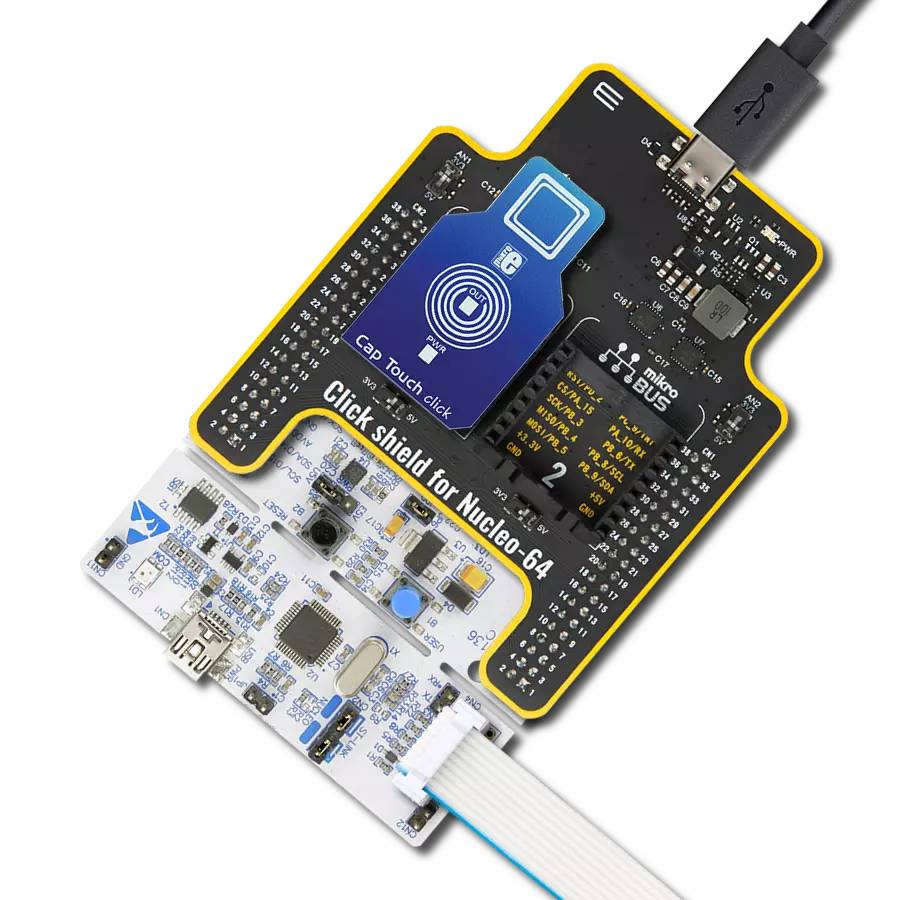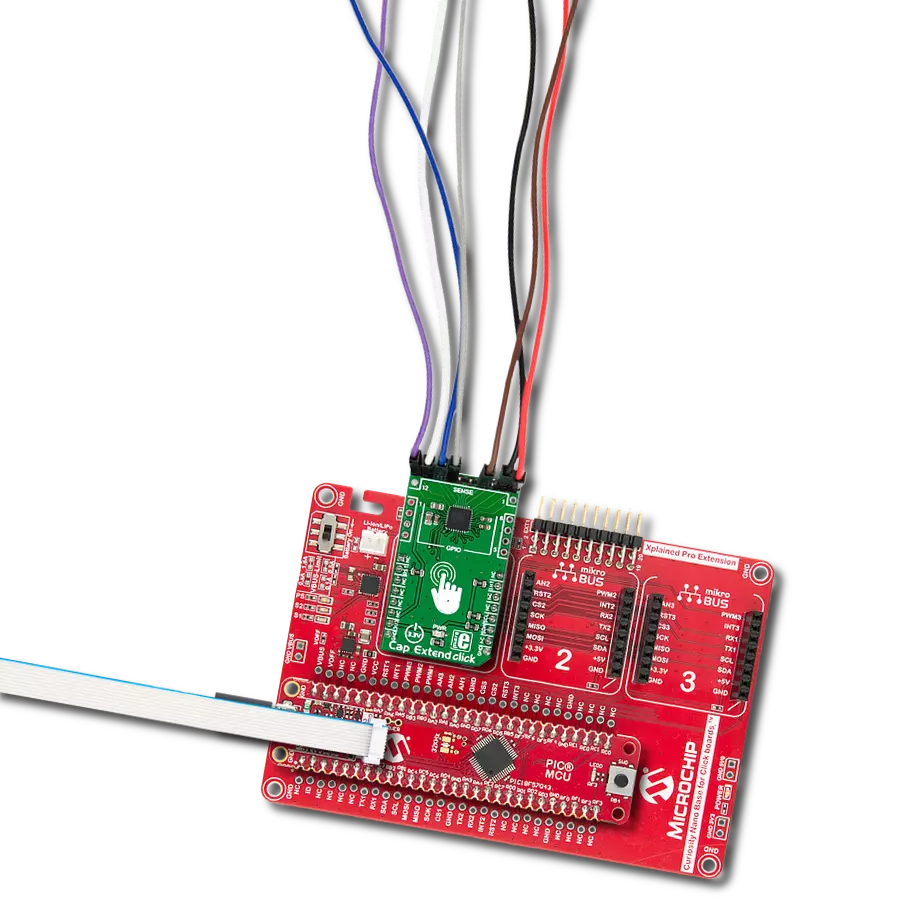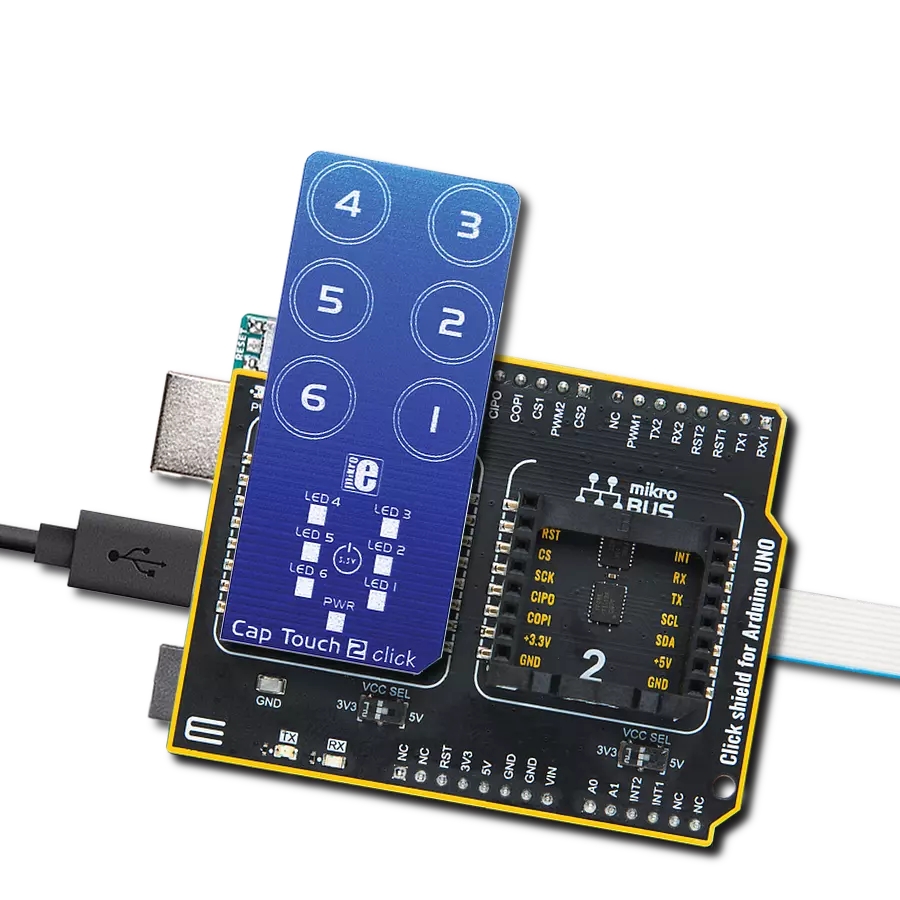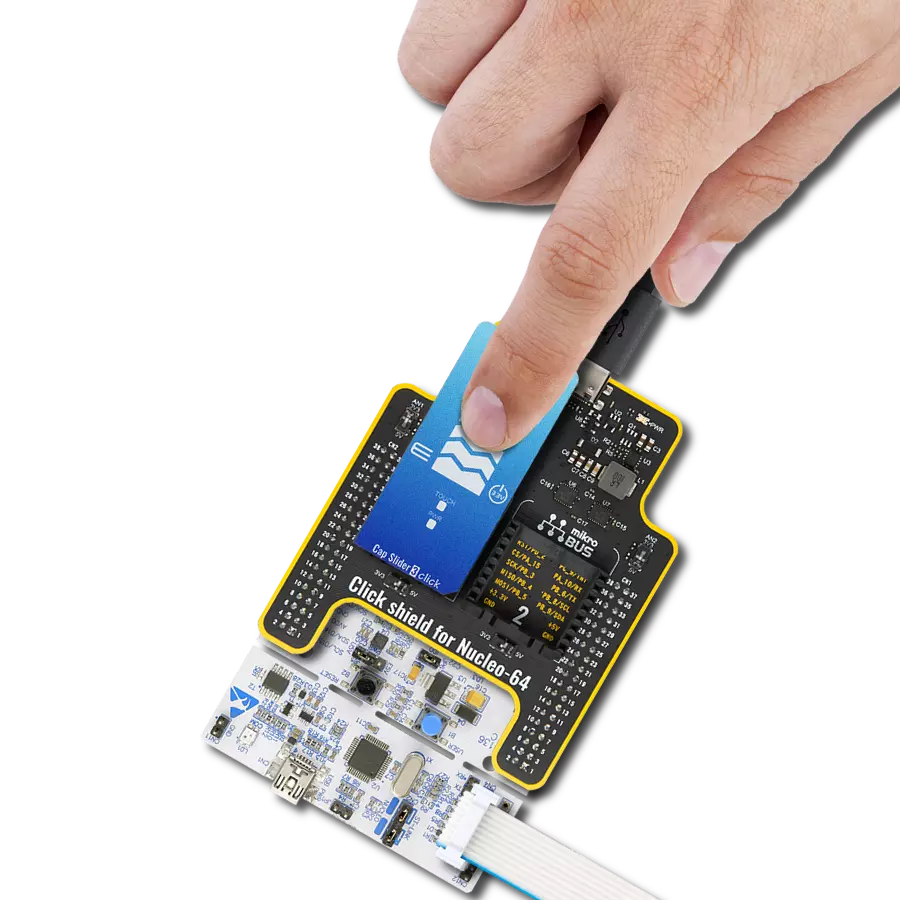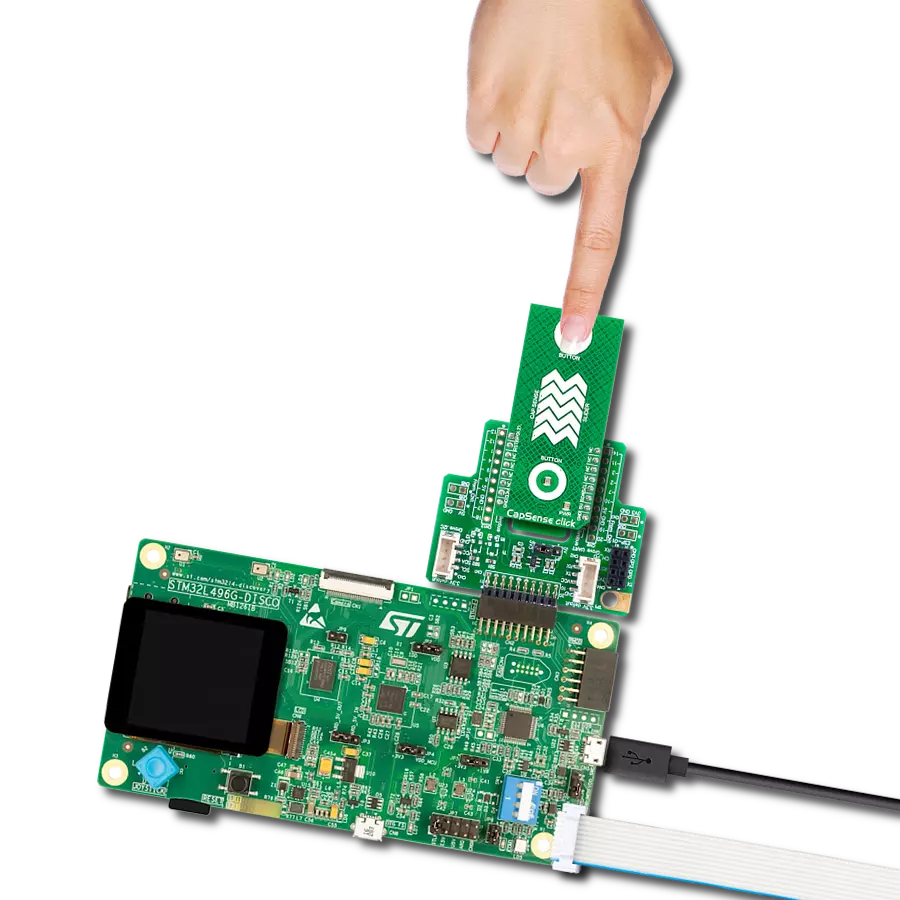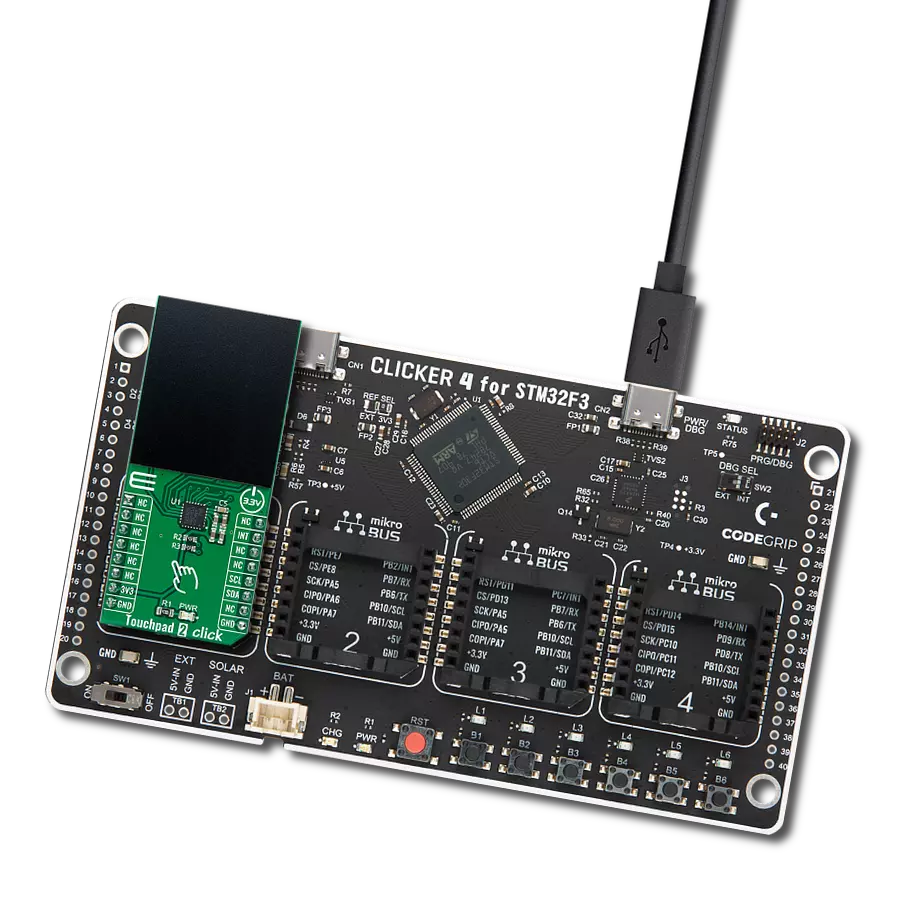Elevate your touch experience with a seamlessly integrated touchpad and microcontroller duo, where smoothness meets intelligence for unparalleled user satisfaction
A
A
Hardware Overview
How does it work?
Touchpad 4 Click is based on the IQS7211A, a tiny trackpad controller designed for multitouch applications using a projected capacitance touch panel from Azoteq. The IQS7211A is part of Azoteq’s latest ProxFusion combination sensors, a multi-sensor technology that offers capacitive sensing, Hall-effect, inductive, and temperature sensing combinations on a single integrated circuit. It allows users to control a trackpad of up to 32 channels and offers high resolution and fast response, low power consumption, and long-term activation supported by environmental tracking. It is also characterized by embedded gesture engine recognition for simple gestures (tap, swipes, hold) and built-in noise detection and filtering. On the Touchpad 4 Click front side, a clearly defined field represents a touchpad area. This area is a matrix
of conductive electrodes on the PCB, electrically isolated from each other, arranged as rows and columns of X and Y. An electrode consists of multiple diamond-shaped elements, each connected to the next with a conductive neck. The controller uses the projected capacitance charge transfer principle on the touchpad area. When a conductive object such as a human finger approaches the sense plate, the detected capacitance will decrease. Observing the measured results at various sensing points on the touchpad area enables the controller to determine proximity/hover detection and contact (touch) detection on all channels and accurately determine the coordinates on the touch area. Touchpad 4 Click communicates with MCU using a standard I2C 2-Wire interface, with a clock of
up to 1MHz in the Fast Mode. An additional ready signal, routed on the INT pin of the mikroBUS™ socket, is added, which indicates when the communication window is available. Thus, it is optimal for the response rate to use the INT pin as a communication trigger. Alongside this pin, this Click board™ has a Reset feature routed to the RST pin on the mikroBUS™ socket, which with a low logic level, puts the module into a Reset state, and with a high level, operates the module normally. This Click board™ can be operated only with a 3.3V logic voltage level. The board must perform appropriate logic voltage level conversion before using MCUs with different logic levels. Also, it comes equipped with a library containing functions and an example code that can be used, as a reference, for further development.
Features overview
Development board
UNI-DS v8 is a development board specially designed for the needs of rapid development of embedded applications. It supports a wide range of microcontrollers, such as different STM32, Kinetis, TIVA, CEC, MSP, PIC, dsPIC, PIC32, and AVR MCUs regardless of their number of pins, and a broad set of unique functions, such as the first-ever embedded debugger/programmer over WiFi. The development board is well organized and designed so that the end-user has all the necessary elements, such as switches, buttons, indicators, connectors, and others, in one place. Thanks to innovative manufacturing technology, UNI-DS v8 provides a fluid and immersive working experience, allowing access anywhere and under any
circumstances at any time. Each part of the UNI-DS v8 development board contains the components necessary for the most efficient operation of the same board. An advanced integrated CODEGRIP programmer/debugger module offers many valuable programming/debugging options, including support for JTAG, SWD, and SWO Trace (Single Wire Output)), and seamless integration with the Mikroe software environment. Besides, it also includes a clean and regulated power supply module for the development board. It can use a wide range of external power sources, including a battery, an external 12V power supply, and a power source via the USB Type-C (USB-C) connector. Communication options such as USB-UART, USB
HOST/DEVICE, CAN (on the MCU card, if supported), and Ethernet is also included. In addition, it also has the well-established mikroBUS™ standard, a standardized socket for the MCU card (SiBRAIN standard), and two display options for the TFT board line of products and character-based LCD. UNI-DS v8 is an integral part of the Mikroe ecosystem for rapid development. Natively supported by Mikroe software tools, it covers many aspects of prototyping and development thanks to a considerable number of different Click boards™ (over a thousand boards), the number of which is growing every day.
Microcontroller Overview
MCU Card / MCU
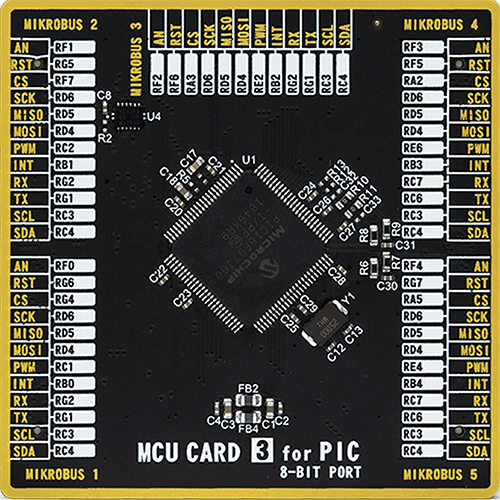
Type
8th Generation
Architecture
PIC
MCU Memory (KB)
128
Silicon Vendor
Microchip
Pin count
100
RAM (Bytes)
3808
Used MCU Pins
mikroBUS™ mapper
Take a closer look
Click board™ Schematic

Step by step
Project assembly
Track your results in real time
Application Output
1. Application Output - In Debug mode, the 'Application Output' window enables real-time data monitoring, offering direct insight into execution results. Ensure proper data display by configuring the environment correctly using the provided tutorial.

2. UART Terminal - Use the UART Terminal to monitor data transmission via a USB to UART converter, allowing direct communication between the Click board™ and your development system. Configure the baud rate and other serial settings according to your project's requirements to ensure proper functionality. For step-by-step setup instructions, refer to the provided tutorial.

3. Plot Output - The Plot feature offers a powerful way to visualize real-time sensor data, enabling trend analysis, debugging, and comparison of multiple data points. To set it up correctly, follow the provided tutorial, which includes a step-by-step example of using the Plot feature to display Click board™ readings. To use the Plot feature in your code, use the function: plot(*insert_graph_name*, variable_name);. This is a general format, and it is up to the user to replace 'insert_graph_name' with the actual graph name and 'variable_name' with the parameter to be displayed.

Software Support
Library Description
This library contains API for Touchpad 4 Click driver.
Key functions:
touchpad4_reset- Reset functiontouchpad4_get_touch- Read touch informationstouchpad_get_channels- Read channel information
Open Source
Code example
The complete application code and a ready-to-use project are available through the NECTO Studio Package Manager for direct installation in the NECTO Studio. The application code can also be found on the MIKROE GitHub account.
/*!
* @file main.c
* @brief Touchpad4 Click example
*
* # Description
* This example showcases ability of the device to read touch coordinates,
* active/inactive channels, and gesture informations.
*
* The demo application is composed of two sections :
*
* ## Application Init
* Initialize host communication modules(UART and I2C) and additional pins,
* for device control. Then resets device and set default configuration where
* Channels and pins are mapped and configured, and set communication with device
* only on touch/event. In the end one of 3 examples is set;
*
* ## Application Task
* There are 3 examples that shocaes ability of the device:
* - Reading touch coorinates and addinal informations of touch strength,
* and touch area and logging them,
* - Reading channel statuses and show them by logging them,
* - Reading gesture events and logging them;
*
* ### Additional Functions
* - void touchpad4_touch_reading ( void );
* - void touchpad4_channel_reading ( void );
* - void touchpad4_gesture_reading ( void );
*
* @author Luka Filipovic
*
*/
#include "board.h"
#include "log.h"
#include "touchpad4.h"
#define TOUCHPAD4_EXAMPLE_TOUCH 1
#define TOUCHPAD4_EXAMPLE_CHANNEL 2
#define TOUCHPAD4_EXAMPLE_GESTURE 3
static touchpad4_t touchpad4;
static log_t logger;
static uint8_t example_selector = 0;
/**
* @brief Touchpad 4 touch info example.
* @details This function reads touch informations and logs them.
* @return Nothing
*/
void touchpad4_touch_reading ( void );
/**
* @brief Touchpad 4 channel example.
* @details This function reads channel informations and logs them.
* @return Nothing
*/
void touchpad4_channel_reading ( void );
/**
* @brief Touchpad 4 gesture info example.
* @details This function reads gesture informations and logs them.
* @return Nothing
*/
void touchpad4_gesture_reading ( void );
void application_init ( void )
{
log_cfg_t log_cfg; /**< Logger config object. */
touchpad4_cfg_t touchpad4_cfg; /**< Click config object. */
/**
* Logger initialization.
* Default baud rate: 115200
* Default log level: LOG_LEVEL_DEBUG
* @note If USB_UART_RX and USB_UART_TX
* are defined as HAL_PIN_NC, you will
* need to define them manually for log to work.
* See @b LOG_MAP_USB_UART macro definition for detailed explanation.
*/
LOG_MAP_USB_UART( log_cfg );
log_init( &logger, &log_cfg );
log_info( &logger, " Application Init " );
// Click initialization.
touchpad4_cfg_setup( &touchpad4_cfg );
TOUCHPAD4_MAP_MIKROBUS( touchpad4_cfg, MIKROBUS_1 );
err_t init_flag = touchpad4_init( &touchpad4, &touchpad4_cfg );
if ( I2C_MASTER_ERROR == init_flag )
{
log_error( &logger, " Application Init Error. " );
log_info( &logger, " Please, run program again... " );
for ( ; ; );
}
touchpad4_reset( &touchpad4 );
init_flag = touchpad4_default_cfg ( &touchpad4 );
if ( TOUCHPAD4_ERROR == init_flag )
{
log_error( &logger, " Configuration. " );
log_info( &logger, " Please, run program again... " );
for ( ; ; );
}
example_selector = TOUCHPAD4_EXAMPLE_TOUCH;
log_info( &logger, " Application Task " );
}
void application_task ( void )
{
if ( !touchpad4_get_ready( &touchpad4 ) )
{
switch ( example_selector )
{
case TOUCHPAD4_EXAMPLE_TOUCH:
{
touchpad4_touch_reading( );
break;
}
case TOUCHPAD4_EXAMPLE_CHANNEL:
{
touchpad4_channel_reading( );
break;
}
case TOUCHPAD4_EXAMPLE_GESTURE:
{
touchpad4_gesture_reading( );
break;
}
default:
{
log_error( &logger, " Select Example" );
break;
}
}
}
}
int main ( void )
{
/* Do not remove this line or clock might not be set correctly. */
#ifdef PREINIT_SUPPORTED
preinit();
#endif
application_init( );
for ( ; ; )
{
application_task( );
}
return 0;
}
void touchpad4_touch_reading ( void )
{
touchpad4_info_t ti;
touchpad4_get_touch ( &touchpad4, &ti );
if ( ( ti.number_of_touches > 0 ) && ( ti.number_of_touches <= 2 ) )
{
log_printf( &logger, "> X->%d\r\n> Y->%d\r\n> Strength->%u\r\n> Area->%u\r\n",
ti.touches[ 0 ].x, ti.touches[ 0 ].y, ti.touches[ 0 ].strength, ti.touches[ 0 ].area );
log_printf( &logger, "**************\r\n" );
}
}
void touchpad4_channel_reading ( void )
{
uint32_t ch_status = 0;
touchpad_get_channels( &touchpad4, &ch_status );
uint8_t shift = 19;
uint8_t row[ 10 ] = { 0 };
for ( uint8_t r = 0; r < 5; r++ )
{
uint8_t row_char_cnt = 6;
for ( uint8_t y = 0; y < 4; y++ )
{
if ( y )
{
row[ row_char_cnt-- ] = '|';
}
if ( ( ch_status >> shift ) & 1 )
{
row[ row_char_cnt-- ] = 'x';
}
else
{
row[ row_char_cnt-- ] = 'o';
}
shift--;
}
log_printf( &logger, "%s\r\n", row );
}
log_printf( &logger, "\r\n" );
}
void touchpad4_gesture_reading ( void )
{
uint16_t gesture_data = 0;
touchpad4_generic_read( &touchpad4, TOUCHPAD4_REG_GESTURES, &gesture_data );
gesture_data &= 0x003F;
if ( gesture_data & 0x0001 )
{
log_printf( &logger, " > Single Tap <\r\n" );
}
if ( gesture_data & 0x0002 )
{
log_printf( &logger, " > Press And Hold <\r\n" );
}
if ( gesture_data & 0x0004 )
{
log_printf( &logger, " > Swipe X - <\r\n" );
}
if ( gesture_data & 0x0008 )
{
log_printf( &logger, " > Swipe X + <\r\n" );
}
if ( gesture_data & 0x0010 )
{
log_printf( &logger, " > Swipe Y + <\r\n" );
}
if ( gesture_data & 0x0020 )
{
log_printf( &logger, " > Swipe Y - <\r\n" );
}
if ( gesture_data )
{
log_printf( &logger, "**************\r\n" );
}
}
// ------------------------------------------------------------------------ END
